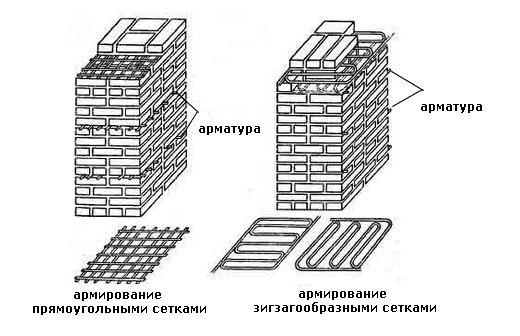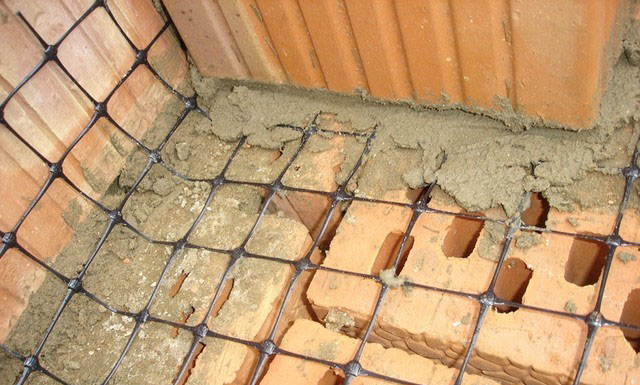The construction of buildings or structures requires mandatory compliance with all construction standards and rules. Many of them belong to the strength indicators of the elements of buildings and structures under construction.

Currently, many technologies have been developed that help increase the strength of almost all structural elements of buildings.
Not left aside and. Many will say that it is not better and better than a good solution or concrete, but it is not. Brickwork can be even stronger if you add some elements in its design.
It can be reinforced for it.
Types of reinforcement

Brickwork reinforcement can be:
- transverse;
- vertical;
- longitudinal.
In transverse reinforce, separate rods or steel mesh are used. Steel rods are prevented during stretching for stretching and bending.
The rod grid is connected by welding or knitting wire. The connection is made in increments of 30-120 mm. In adjacent seams instead of the grids, it is unacceptable perpendicular to lay separate strains.
The grid made of large-diameter reinforcement leads to a decrease in strength, increasing the thickness of horizontal seams.
The reinforcement of walls, pillars and simpleness is made by a welded masonry mesh, which can have a zigzag, rectangular or square shape.
To prevent corrosion process, the metal mesh should be recessed into a solution of at least 2 mm on each side. The minimum seam thickness at the same time will be approximately 14 mm, including about 5 mm per grid.
The grid is placed in every fifth row of masonry. If the brick is greater than the standard size, then the rectangular grid is needed in every fourth row.
The manufacture of zigzag fittings is made only on a construction site. This all has the appearance of a rod with a diameter of 5-15 mm, twisted every 5-10 cm. The zigzag wire of a large diameter is impossible, since the seam will be too wide.
Laying zigzag fittings is also carried out every fifth row. It is placed by pairs and at right angles in relation to the two preceding rows. This method of masonry reinforcement is rather simple, and cash flow will be minimal. Well suited for private houses. Laying of jumpers and other similar elements are made in conjunction with transverse reinforcement having a view of straight rods.
Reinforced Brick Wall Laying
In seismically active areas, the walls of structures are strengthened by vertical and longitudinal reinforcement methods. This reinforcement is used to absorb stretching deformations when erecting thin walls, pillars and partitions.
Grids are placed with a protrusion for the inner surface of the simpleness of 2-3 mm. This serves as a kind of fittings location in the masonry.
The longitudinal method of reinforcement of the wall of the brick can be performed by the AI \u200b\u200band AII fittings. In this case, the amount of solution (thickness) will be directly dependent on the humidity level. With moderate humidity, the layer thickness does not exceed 10-12 mm. Increased humidity requires masonry on a layer of a solution having a thickness of 20-30 mm.
To rein the brick masonry of walls in vertical planes, fittings of class AI and Bi with a diameter of 3-8 mm applied.
There is an alternative to reinforcement grids - a modern reinforcing material called the CPVS grid. Such meshs at high strength and reliability indicators are much easier for reinforcement and more convenient in the installation.
In ordinary laying, the wall is often rejected by direct reinforcement. Several rods of the reinforcement are stacked in the width of the wall and are implanted by 15-20 cm in the masonry, thus enhancing the jumper and evenly distributing the loads rendered by brick on the opening. The glutter is laid every 2-3 rows depending on the pressure rendered to the jumper. The diameter of direct reinforcement depends on the masonry seam (its thickness). It is necessary to know that the opening or jumper should not exceed 2 m.
Brick pillars reinforcement
The laying of columns has two options:
- under the bearing structures. The function of the pillars - a support that can withstand loads at a small area of \u200b\u200bthe base base based on the foundation. Only vertical loads turn on such pillars;
- fence posts. The designs of such poles are divided into two types: for gates and wickets and as separate sections.
Reinforcement of brick masonry is a fairly simple process, but it is mandatory. Reinforcement does not require any special knowledge, but plays a crucial role in the durability and reliability of the structure. To prevent errors and avoid further problems, it is better to seek advice from specialists. This consumption is minimal compared to the possible cost of restoring the wall. When selecting fittings, it is necessary to take into account all the nuances and subtleties of its purpose and comply with all the rules and rules associated with reinforcement.
